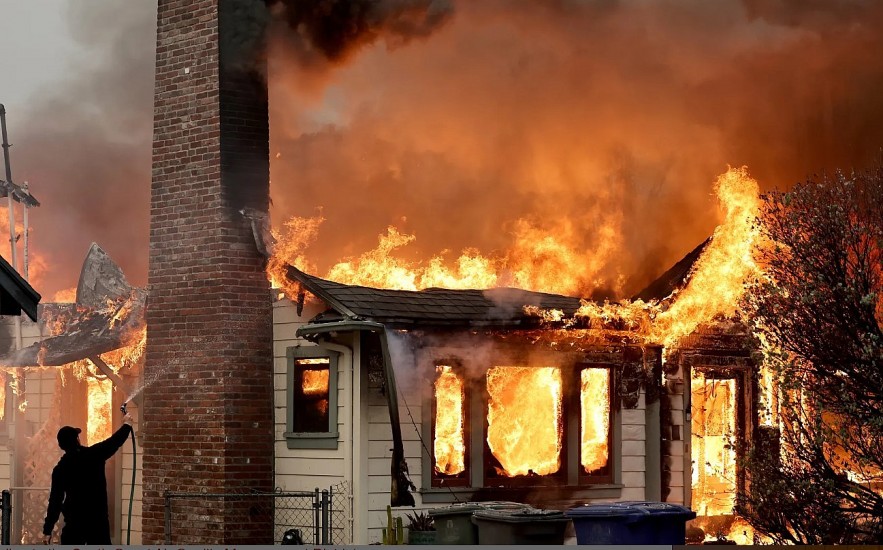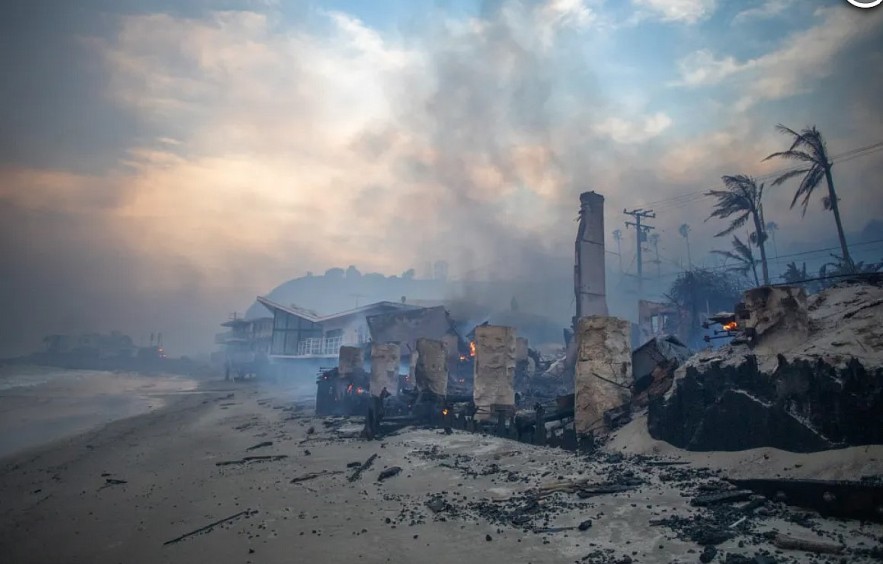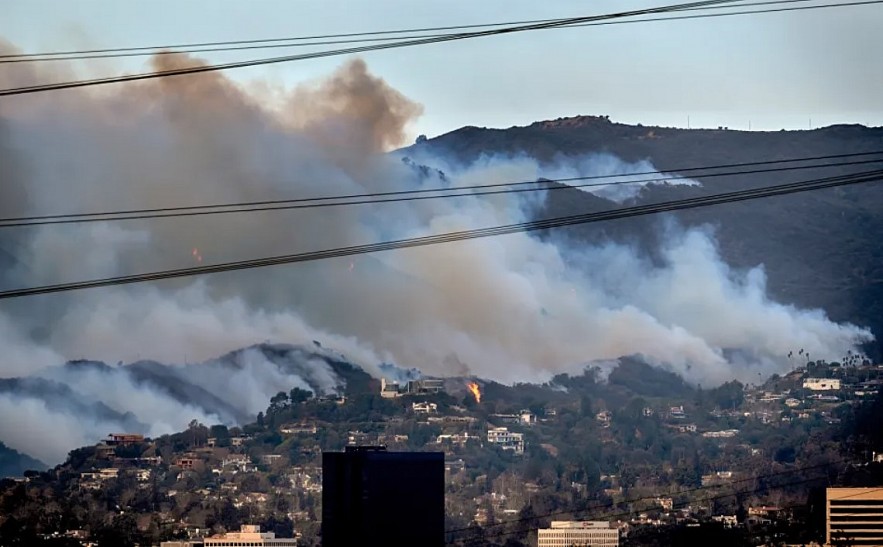California Wildfires Devastate the Los Angeles Area, 70,000 People Forced to Evacuate
 |
| California wildfires |
Highway closures and mandatory evacuations for tens of thousands of people were caused by the massive Palisades Fire that started in Los Angeles on Tuesday afternoon. On the opposite side of Los Angeles County, in the foothills of Pasadena, the Eaton Fire started later Tuesday.
Quick Facts:
• At least five wildfires are currently raging in Los Angeles County, affecting areas such as the Pacific Palisades and Sylmar neighborhoods, as well as a region near Pasadena.
• As of Wednesday afternoon, officials report that the fires remain completely uncontained.
• California Governor Gavin Newsom has declared a state of emergency, cautioning that the most intense winds were anticipated between Tuesday at 10 p.m. and Wednesday at 5 a.m. President Biden has also announced plans to approve a federal emergency declaration.
• Evacuation orders have been issued for over 70,000 residents as the wildfires endanger approximately 28,000 structures across the LA area.
• By Wednesday afternoon, more than 400,000 people in Los Angeles County were without power.
• The fires are being fueled by strong Santa Ana winds blowing in from the east, with authorities warning that the situation could worsen.
Fierce wildfires continue to devastate the Los Angeles area, leaving a trail of destruction as they sweep through homes, businesses, and natural landscapes. The fires, driven by powerful Santa Ana winds, have forced tens of thousands to flee their homes, creating a state of chaos and emergency across the region. Here is the latest on the unfolding disaster.
Wildfires Ignite and Spread Rapidly
The wildfires, several of which ignited on Tuesday, have rapidly expanded, consuming large swaths of land and leaving residents scrambling for safety. The notorious Santa Ana winds, gusting at speeds exceeding 70 mph (112 kph) in some areas, have fanned the flames, making containment efforts exceedingly difficult.
The winds, known for their ferocity during California's wildfire season, have also grounded firefighting aircraft, leaving crews on the ground to battle the blazes without aerial support. This has further complicated efforts to control the fires, which have engulfed picturesque neighborhoods and threatened iconic locations often associated with Hollywood celebrities.
Palisades Fire
One of the most alarming fires, the Palisades Fire, began around 10:30 a.m. Tuesday. It has scorched approximately 4.5 square miles (11.6 square kilometers) in the Pacific Palisades neighborhood. The fire has rained flaming embers onto trees and rooftops, creating a harrowing scene for residents who rushed to evacuate.
Evacuation efforts have been hindered by traffic jams, with panicked residents leaving their vehicles abandoned, blocking emergency crews from accessing critical areas. In one instance, firefighting crews resorted to using bulldozers to push stranded cars out of the way.
Eaton Fire
North of Pasadena in the Altadena area, the Eaton Fire has emerged as one of the largest fires, growing to an estimated 16.6 square miles (43 square kilometers) by late Wednesday morning. This fire has had a profound impact on vulnerable populations, with employees at a senior center seen pushing residents in wheelchairs and hospital beds to safety in a parking lot.
 |
| On January 8, 2025, in Malibu, California, iconic beach houses smolder from the Palisades Fire along the Pacific Coast Highway during a strong windstorm. |
Hurst Fire
Another significant blaze, the Hurst Fire, ignited late Tuesday evening in Sylmar, a neighborhood in the northernmost part of Los Angeles. By early Wednesday, the fire had expanded to nearly a square mile (2.6 square kilometers) and prompted evacuation orders for surrounding communities.
Evacuations and Threatened Structures
Evacuation orders have affected more than 80,000 residents across multiple neighborhoods, including Pacific Palisades, Santa Monica, Altadena, and Sylmar. According to fire officials, more than 28,000 structures are currently under threat from the wildfires.
In some areas, such as the Pacific Palisades, more than 13,000 structures are at immediate risk. The Eaton Fire has led to the evacuation of over 50,000 people, with crews working tirelessly to protect lives and property.
Power Outages Impact Thousands
Adding to the crisis, approximately 400,000 customers in Southern California have been left without power due to the fires and the high winds. Los Angeles County has been hit particularly hard, with over 260,000 customers affected. Power outages have complicated evacuation efforts and left many without access to vital resources.
A Unified Response
California Governor Gavin Newsom has declared a state of emergency and deployed more than 1,400 firefighting personnel to combat the blazes. In an unprecedented move, the Los Angeles Fire Department issued an urgent plea for all off-duty firefighters to assist in the firefighting efforts.
Meanwhile, President Biden has pledged to sign a federal emergency declaration, ensuring that additional resources and support are made available to affected communities.
 |
| Spot fires along a hillside burn the Brentwood section of Los Angeles on Wednesday, Jan. 8, 2025 |
Weather Conditions and Red Flag Warnings
The National Weather Service has issued ongoing red flag warnings, highlighting the extreme fire weather conditions. Meteorologists have noted the combination of strong winds and exceptionally dry humidity levels as a recipe for disaster. Some mountainous and foothill regions, which have not experienced significant rainfall in months, are particularly vulnerable.
Forecasts predict that winds could reach speeds of up to 100 mph (160 kph) in higher terrain. These conditions are expected to persist, further complicating containment efforts and heightening the risk of new fires igniting.
The Road Ahead
As the fires continue to burn, officials are urging residents to remain vigilant and heed evacuation orders. Shelters have been established across the region to accommodate displaced residents, while firefighters and emergency crews work around the clock to contain the blazes.
The current wildfires serve as a stark reminder of the growing challenges posed by climate change, prolonged droughts, and the increasing frequency of extreme weather events. As Southern California battles this crisis, the nation watches with bated breath, hoping for an end to the destruction and a swift recovery for the affected communities.























